Story & Photos by Vicki Andersen
It does strike me as a bit bizarre to be traipsing through the jungle like a real-life Indiana Jones, yet yearning to hear Scotty's voice at the controls of the transporter asking where to beam me. I know where I'd like to be: right here, in the ancient Maya city of Tikal. The when is what I'm not sure of: around 600 BCE when the inhabitants were clearing ground to construct the first buildings at this site? during the seventh or eighth centuries when its cultural and artistic achievements were at their height? or the mid-1970s, when George Lucas chose Tikal to represent the hidden rebel base situated on Planet Yavin's fourth moon in the first Star Wars film.
No, scratch the first and third choices. I would much prefer to see these structures glistening in their painted stucco beauty under the blazing Central American sun. I try to visualize the aristocracy hustling across white-plastered plazas, intent on the daily mechanisms of running one of the most powerful of all Maya cities. I would love to see a priest in full ceremonial regalia climbing the steep steps to the top of one of these towering pyramids, whose smooth stuccoed surface was adorned with red paint and blue trim.
I would relish a chance to watch proud warriors fashioning their flint blades and discussing strategy for the next Star War, real historical events (long before Mr. Lucas came to visit) that were so-named by archaeologists because astrological portents were used to decide when the battles should be undertaken. I would enjoy watching children play with their clay dolls and tiny wheeled toys - the only use the Maya made of the wheel. I might be tempted to join the women as they ground maize in front of their wattle and dab huts, or sit in the shade of a ceiba tree while weaving colorful cloth on a backstrap loom.
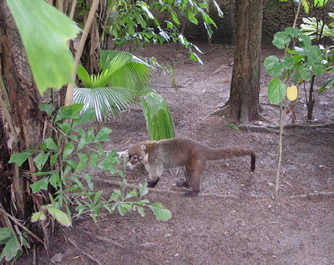 |
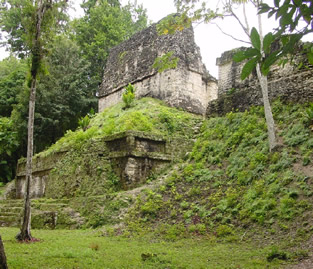 |
|
Coatimundi
|
Unrestored Temples
|
But I'm over a thousand years too late, and instead of priests I watch iguanas scamper up ancient stairways hidden under a carpet of green. In place of children frolicking, I am entertained by troupes of spider monkeys swinging through the dense canopy. Rather than women baking tortillas, I watch coatimundi scratching for tidbits in the undergrowth. Although the painted stucco has fallen from the buildings and a thick layer of vegetation buries the plastered plazas, those monumental structures still evoke a feeling of awe, amazement and reverence in me.
Emerging upon the Mesoamerican scene around 2,000 BCE, the Maya became one of the most brilliant and powerful cultures known - a society of scientists and scribes, skilled architects and sculptors, fierce warriors and a powerful ruling class. Mostly comprised of independent states, they made pacts with and war upon each other while engaged in a widespread network of trade. During their Classic Period (250-900 CE) the Maya built more cities than ancient Egypt, and for every pyramid erected in the Nile Valley, the Maya constructed more than 100. They were the first to conceive of the concept of zero, and their sophisticated mathematics helped them become phenomenal astronomers who could forecast eclipses and comets thousands of years into the future, and whose calendar was as precise as ours.
Known as El Peten, this region in northern Guatemala includes the most Maya cities (reportedly over 100 of them) from the Classic Period, many still buried beneath a tangle of plant life. The Peten's lush ecosystem includes dozens of species of mammals, 500 species of birds, over 800 species of trees, and countless varieties of insects and reptiles. To protect these riches, the 230-square-mile Tikal National Park was created in 1958. UNESCO has declared it a "Monument of the World's Heritage", the only place in the world designated as both a cultural and natural heritage site. But as wonderful as the flora and fauna might be, it's what man built, and then abandoned, that captivates me.
Largest city of the Classic Period, Tikal's massive and extensive ruins were built upon for more than 1,100 years. Eventually the site covered over 25 square miles and housed some 100,000 residents. More than 3,000 separate buildings have been at least partially excavated, and estimates say that 10,000 earlier constructions many lie beneath them. There are pyramids and temples, palaces and shrines, ceremonial platforms and residences, terraces and plazas, ball courts and causeways. Strangely, the Maya accomplished these creations without the use of metal tools or beasts of burden.
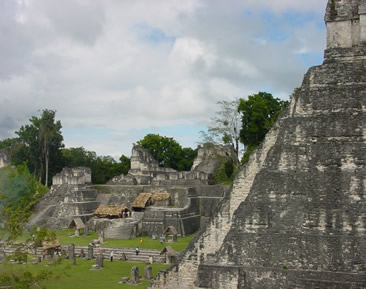 |
|
|
Great Plaza
|
North Acropolis
|
The excavated and restored portion of Tikal is massive. From the archaeological site entrance to the Great Plaza is a one-mile jaunt over undulating terrain. From there it is about 20 minutes to each of the other main groups, much more if you linger to marvel at the edifices, infusing yourself in the mood of this ancient city. The Great Plaza is considered the heart of Tikal, containing ceremonial buildings, residential and administrative palaces, and the ubiquitous ball court. Four superimposed plaster floors, each covering about 2.5 acres, have been found beneath much of the Great Plaza, the earliest estimated to have been laid around 150 BCE and the latest near 700 CE.
Situated on the north side is the North Acropolis, a cluster of pyramid-style temples atop a platform elevated about 40 feet above the Plaza. Nearly 100 buildings sit atop more than a dozen earlier versions, the earliest dating to 400 BCE. The North Acropolis is approached by the North Terrace, a 230-foot wide stairway populated with nearly 70 carved stone stelae and altars.
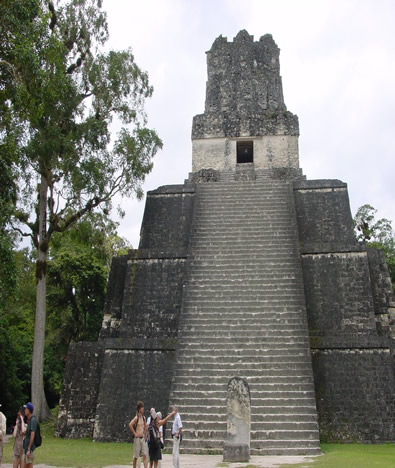 |
|
|
Temple I
|
Temple II
|
Temples I and II, bounding the Great Plaza on the east and west respectively, are among the tallest in Tikal. Symbol of the nation of Guatemala, Temple I was a monument to Ah-Cacaw, Tikal's greatest king, and his burial inside the Temple was accompanied by rich offerings that included some 180 pieces of worked jade ornamenting his body. Temple II's truncated top sets it apart from the other soaring temples. Incredible acoustics exist between these two making it possible to talk between the tops of the two structures without raising your voice.
|
Temple IV Stairway
|
View from the top of Temple IV
|
Sitting on the western outskirts of the restored portion of Tikal is Temple IV, rising over 200 feet and topped with a three-room temple with 40-foot thick walls. Only the upper levels have been restored, accessible by wooden staircases built over the stone rubble and root-entangled pyramidal base. From the top are dramatic views of Tikal's tallest pyramids, rising proudly above the jungle canopy. (This view should ring a familiar bell with Star Wars fans.)
Two of my favorite clusters are Mundo Perdido, or the Lost World Complex, and the Plaza of the Seven Temples. Neither group gets the hordes of tourists that Temple IV or the Great Plaza garner, and they still invoke an otherworldly feeling, transporting my mind and soul far backward from the 21st century.
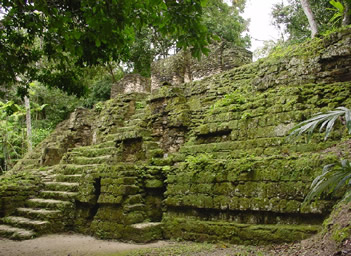 |
|
|
Mundo Perdido's Great Pyramid
|
Mundo Perdido Structure
|
Mundo Perido is among the oldest of all structural complexes at Tikal, its earliest structures dating prior to 500 BCE. To early explorers, it brought to mind Sir Author Conan Doyle's classic 1912 novel "The Lost World", and thus it received its name. Centerpiece is the 100-foot-tall Great Pyramid, which began as a small astronomical observatory platform and grew into a royal necropolis.
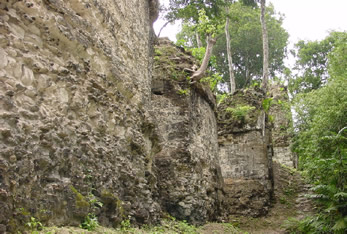 |
|
|
Plaza of the Seven Temples
|
Plaza of the Seven Temples
|
The Plaza of the Seven Temples boasts seven structures snuggled close to each other, and an unusual triple ball court. There is a mysteriousness to these small structures swathed in jungle cover, massive trees growing out of the tops while their root systems lace a precarious hold across the walls of the buildings. Fortunately for archaeologists and the visitor, but regrettably for my wanderlust imagination, this group is undergoing restoration.
|
Uaxactun Village
|
Uaxactun Dwelling
|
Fifteen miles north of Tikal, along a bumpy rock road, is Uaxactun (wah-shahk-TOON). An abandoned airstrip cuts through these archaeological ruins, and a small village lines the dusty landing strip. One of the oldest and longest-existing Maya cities, evidence points to habitation as far back as 900 BCE. Rising to prominence in the Early Classic Period, it fell to Tikal in 378 CE and spent the next few centuries under its domination.
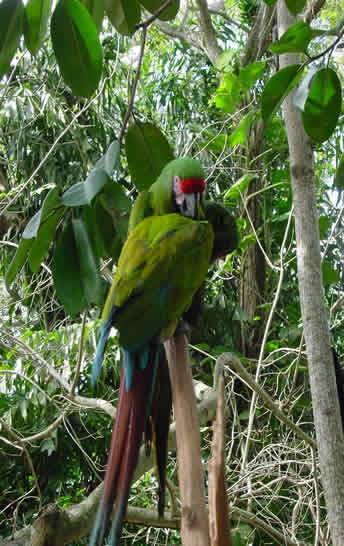 |
|
|
Parrots
|
Ceiba Tree
|
Meandering west of the village along one of the site's ancient roadways, I pass chattering parrots, unperturbed by my intrusion. Strangler figs creep their way up massive mahogany trees, ceiba tree roots spread in serpentine waves across the ground, and the scent of crushed allspice leaves assails my senses. As I approach Group A, I am saddened to see the damage inflicted by early Carnegie-sponsored archaeologists whose haphazard search for graves, including the inexcusable use of dynamite, nearly destroyed the buildings themselves.
Defining the eastern border of Group A's Main Plaza is Structure A-5, which was added to and upon for hundreds of years, slowly transforming it from three small temples into a huge, complex structure that became more residential in nature. A short distance to the east I find Structure A-18. Most of its lower portion still lies beneath jungle growth, although a few door lintels of zapote wood and some original interior plaster can still be seen.
|
Structure A-5
|
Temple of the Masks
|
A few hundred yards east of the airstrip is Group E, a complex of interesting buildings aligned to form an astronomical observatory. Focal point of the plaza is the stunning Temple of the Masks, each of its four stairways flanked by large stuccoed masks. As the Maya often did, they built over the first structure, which preserved the original work. When the ruined outer structure was removed, the earlier pyramid emerged brilliant white. Time and lack of maintenance allowed it to become overgrown and stain the original plaster. Now recleared, the surface is darkly mottled and details of the beautiful masks are blurred.
I sit atop this ancient pyramid, gazing across the tops of the other astronomically-aligned structures that defined the solstices and equinoxes. I wonder what signs the heavens presented on that fateful day back in the 4th century when Tikal decided to invoke a Star War against its rival neighbor. And I think how surprised the majority of Star Wars fans would be to know that the real-life locale for the rebel base was, indeed, a launching point for real-life Star Wars.
IF YOU GO: Near the entrance to the Tikal ruins are the Tikal Museum and the
Tikal Lithic Museum. Nearby is a restaurant and a small Market with a nice selection
of crafts, books and souvenirs. Inside the archaeological site, restrooms and
cold beverages can be found in a couple of locations. Uaxactun offers restrooms
and picnic shelters but no food or beverages, although the latter can be purchased
in the village. Allow about 2.5 hours to see the sites at Uaxactun, and at least
one full day (two is much better) to see the main points at Tikal. Both sites
are open daily. Flores, with an array of hotels, and its sister city Santa Elena,
with the closest airport, are an easy 1-hour commute on good highway, and there
are three jungle lodges at Tikal. If you'd like to hook up with an excellent,
knowledgeable and reliable tour company, contact Four Directions (Cuatro Direcciones)
in Guatemala City (www.fourdirections.com.gt).